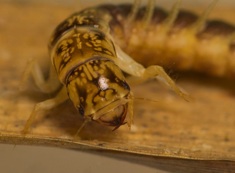Life cycle

journey of life for sialis velata
Eggs: When a female alderfly lays her eggs, she can lay anywhere from 200 to 500 eggs that are cylindrical with rounded ends and dark brown in color(Richards et al. 1965). She deposits them on the stems of aquatic plants overhanging the water such as Taxadium distichum or bald cypress (Locklin et al. 2006). Between March and April, hatching occurs and the larvae wriggle out of the eggs and fall into the water (Herbert 1956).
Larvae: Larvae are completely aquatic and predacious insects. Their feathery structure of gill filaments provides for a large surface area when obtaining oxygen from the water. Oxygen is taken in through the gill filaments, passes through the thin cuticle or skin, and passes through a system of tubules which disperse the oxygen to the cells that need it. During growth, larvae molt there skin up to 10 times before crawling onto the banks and burrowing to start the next phase of their lives (Anderson et al. 2003).
The larvae phase can last from 1-5 years depending on the environmental conditions. The cooler the environment the longer the life cycle (EcoSpark). Between November and December, larvae are in their last instar (molting stage) before they undergo metamorphosis (Locklin et al. 2006).


Alderfly life cycle. Photo from Encyclopedia Britannica.
Alderfly larvae. Photo by Neil Phillips
Pupal: The pupal stage lasts between 1 to 4 weeks in a burrow where they pupate into adults through metamorphosis (EcoSpark). The origin of metamorphosis in Sialis is found to be in the metathorax and first abdominal segment (Richards et el. 1964). While undergoing metamorphosis, the pupa have the ability to move their legs and mouthparts. This allows the pupa to be able to give a sharp bite to any predators that come close. When metamorphosis is complete, the pupa travel to the surface and shed their skin one more time (Anderson et al. 2003).
Adult Alderfly. Photo by Crystal Ray.

Adult: The adults emerge in late spring to mid-sumer ready to mate. Alderfly mating occurs on plants or rocks close to the water (EcoSpark). To signal a mate, the alderfly vibrates the abdomen making a buzzing noise when they sense an alderfly of the opposite sex near by. Fertilization occurs when the male transfers a gel-like package of sperm cells (spermatophore) to the female (Anderson et al. 2003). When it comes time to lay her eggs, the female finds a shady place to lay her eggs to protect them from the heat and sun (EcoSpark).
The adult phase of the alderfly is very short lived. They can live a few days to a few weeks. Once mating occurs, the adult alderfly will die shortly after depositing the eggs (EcoSpark).

Alderfly eggs on a plant overhanging the water. Photo by Neil Phillips.
